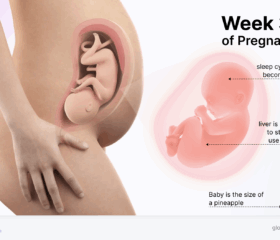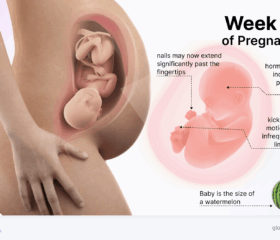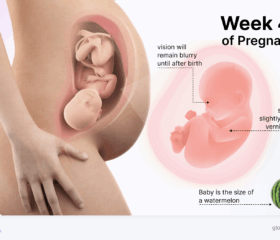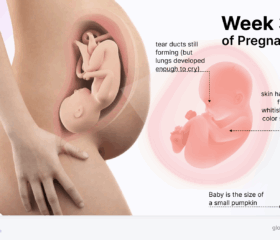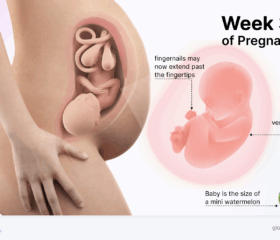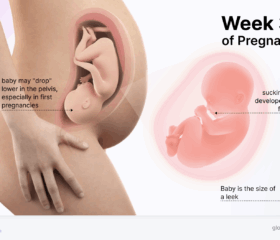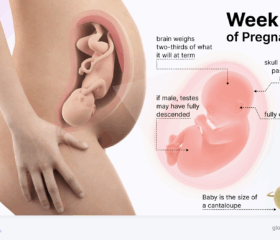Pregnancy Week-by-Week
15 Weeks Pregnant
Your baby is as big as an apple.
3.98
inches
2.47
ounces
You may want to consider certain (optional) tests or screenings at this stage to check how your baby is getting on.
In this article, we’ll cover how your baby is developing, as well as how you can manage your remaining symptoms and prepare for what’s ahead. Read on to find out what’s in store for you in your 15th week of pregnancy.
Your baby at 15 weeks
At 15 weeks, your baby is about the size of an apple, measuring just under 4 inches long and weighing in at just over 2.47 ounces. 1 His legs are now longer than his arms, and he’s already started kicking.
Big changes are happening to his:
- Body: Your baby’s bones are hardening—a process called ossification—and would show up on an X-ray if you got one. His skin is still translucent, with his blood vessels developing below it.
- Sensory development: His ears are moving into place on the sides of his head, and his eyes are gradually shifting toward the front of his face. Although your baby’s eyes are still closed, he might have started to hear through those tiny ears.
- Movements: Your baby is hard at work practicing important survival skills, including breathing, swallowing, and sucking. He’s also moving all of his limbs, although you’re unlikely to actually feel your baby kicking just yet.
- Heart: Your baby’s heartbeat has started, and if you haven’t heard it yet, you will soon. At your next prenatal visit, your doctor will probably use a Doppler device to pick it up.
- Lungs: Your baby will continue breathing in amniotic fluid (not air) until he’s ready to come into the world, but his lungs are developed enough for them to occasionally hiccup inside your womb, although you won’t actually feel that.
When can you feel your baby’s movements?
Most first-time mothers first feel their baby’s movements, known as quickening, at some point between 16 and 22 weeks. If you’ve been pregnant before, you may recognize the fluttering sensations a little earlier.
Don’t worry if you haven’t felt anything yet—your baby is moving, but the motions are still small enough that his activity may go unnoticed for now.

Changes in your body in week 15
At week 15, it’s not just your baby who’s changing. Your body is also adjusting to the second trimester of pregnancy. There’s a good chance your baby bump has finally made its debut, especially if this isn’t your first pregnancy.
For first-time mothers, you may start showing your pregnancy a little later. Your uterus is stretching for the first time, so it’s likely to be a little slower.
While some of the more troublesome symptoms of early pregnancy, like morning sickness (nausea) and fatigue, should have eased up by this point, other symptoms may start up or continue. Common symptoms you may experience at 15 weeks include:
- Bleeding gums: Hormonal changes can make your gums more sensitive to plaque, causing swelling and bleeding when you brush or floss. This condition is known as pregnancy gingivitis.
- Heartburn and indigestion: Your digestive muscles may be unusually relaxed while you’re pregnant, which can lead to acid reflux (heartburn) after meals.
- Nasal congestion and nosebleeds: Your increased blood flow and sensitive nasal membranes might lead to a stuffy nose or occasional nosebleeds.
- Round ligament pain: It’s normal to feel occasional sharp pains on the sides of your lower abdomen. The ligaments supporting your uterus are stretching to accommodate your baby’s growth.
- Increased libido: Not all symptoms are bad, right? With that renewed boost of energy, many women experience a renewed interest in intimacy during this phase of their pregnancies. As long as your doctor gives you the all-clear, sex during pregnancy is fine. That said, if you’re not feeling particularly steamy, don’t panic, as this varies from person to person.
- Pregnancy brain: Are you more of a scatterbrain lately? Pregnancy brain, or “mommy brain,” one of the hallmark pregnancy symptoms, may make you more forgetful or disorganized. Some research suggests this may be due to your brain’s gray matter volume decreasing during pregnancy. Fortunately, your brain will rebound after birth. 2
If new symptoms show up, note them down in a pregnancy tracker app. Don’t hesitate to speak to your doctor if any of these new symptoms concern you.
How to look after yourself and your baby at 15 weeks
At this stage, many women breathe a sigh of relief. With fewer sources of discomfort and more energy, you’ll probably be able to enjoy yourself and connect with your baby’s development more than you could in your first trimester.
However, as you venture further into your second trimester, your baby will grow more demanding. Let’s look at how you can take care of yourself and your baby at 15 weeks:
Make sure you’re eating enough
If you began your pregnancy at a healthy weight, you’ll probably need to gain about 1 pound per week during this trimester. To meet this target, you’ll want to eat an extra 300–350 calories per day to your pregnancy diet. 3
Unfortunately, that doesn’t give you free rein to gorge on cookies or chips. Focus on nutritious foods like lean proteins, whole grains, fruits, and vegetables to make every bite count.
Look after your teeth
As mentioned, your hormonal changes during pregnancy can increase the risk of gum inflammation and gingivitis, making dental care more important than ever. To protect your oral health:
- Brush gently at least twice a day with a soft-bristled toothbrush.
- Floss daily to remove plaque between your teeth.
- Visit your dentist for routine cleanings and checkups. Let them know you’re pregnant to ensure they give you appropriate care.
Maintaining these habits helps prevent complications, such as periodontitis, which can be linked to preterm labor and low birth weight.
Watch for the signs of prenatal depression
While pregnancy is often seen as a joyful time, it’s challenging, too, and it’s normal to have mood swings or persistent feelings of sadness during it.
Your emotional health is just as important as your physical health, and if these mild symptoms become unrelenting or particularly severe, you could be suffering from prenatal depression.
Other signs of depression include:
- Persistent feelings of sadness or hopelessness
- Withdrawal from loved ones
- Difficulty concentrating or making decisions
- Changes in your sleep or appetite
If you notice yourself frequently suffering from any of these symptoms over the course of two weeks or more, contact your doctor. If you have thoughts of injuring yourself, notify your provider immediately. They’ll probably refer you to a mental health specialist, who will help you get into a better mental space in time for your baby to arrive.
Manage your stress levels
Stress is a natural part of pregnancy. Try these coping strategies:
- Mindfulness practices: Activities like meditation or deep breathing can help you stay present and calm.
- Gentle exercise: Prenatal yoga, walking, or swimming can improve your mood (as well as keep your body in the best possible shape)
Make time to connect with other people, too, whether that means just carving out some time to chat with your loved ones or seeking out a support group for moms-to-be.
Snack well and drink enough water
It’s important to stay hydrated; this will help your body maintain its blood and amniotic fluid levels. Keep a water bottle handy and aim to drink consistently throughout the day.
For pregnancy-friendly snacks, choose options that are rich in both nutrients and energy, such as:
- Fresh fruit and nut butter
- Greek yogurt with berries
- Nuts and dried fruit (watch out for added sugar)
- Whole-grain crackers with cheese
Eating smaller, more frequent meals is also a great way to avoid getting heartburn, as well as avoiding known triggers, such as acidic, greasy, or spicy food.
Pregnancy tests you can opt for at 15 weeks
At 15 weeks, there are certain tests you can take to gauge your baby’s health and development. These are optional (unless your doctor orders them), and it’s totally up to you whether you take them or not.
The two main tests you can take at week 15 are:
Quad screen
This non-invasive blood test measures four substances produced by your baby and placenta, which your doctor can use to assess the risk of your baby developing conditions such as Down syndrome and spina bifida. 4
Amniocentesis
Amniocentesis is a diagnostic procedure that’s typically performed between 15 and 20 weeks. It involves extracting a small amount of amniotic fluid to test for chromosomal abnormalities, genetic disorders, and certain neural tube defects such as spina bifida. 5
Doctors often recommend it when they see something that concerns them, such as:
- Abnormal results from earlier screenings, like the quad screen.
- A history of genetic conditions in your family.
It’s also a fairly routine test for mothers aged 35 or older (past this age, the risk of chromosomal abnormalities increases).
While amniocentesis is generally safe, it carries a small risk of complications. Discuss your medical history and any concerns you have with your doctor to decide if this test is right for you.
Can you find out your baby’s sex at 15 weeks?
While you may be eager to find out your baby’s sex, it’s still a bit early to expect a definitive answer from an ultrasound. Most providers recommend waiting until the 18- to 22-week anatomy scan for this. At that point, you’ll be able to get more accurate results.
However, if you choose to undergo amniocentesis, the test can also reveal your baby’s sex as part of the genetic analysis.
Tips to feel more comfortable at 15 weeks
There are a few simple adjustments you can make to stay comfortable and prepare for the weeks ahead:
- Start sleeping on your side: As your baby grows, you’ll need to avoid the wrong sleeping positions for pregnancy. For example, lying on your back can place pressure on a major blood vessel and affect your circulation. Sleeping on your side, especially your left, alleviates this. If you’re having trouble making the transition, consider getting a pregnancy pillow. 6
- Invest in maternity clothes: If your regular wardrobe feels snug, it might be time to shop for maternity staples. Look for loose, stretchy, and comfortable fabrics that support your growing belly.
- Explore prenatal classes: This is a great time to research and sign up for prenatal classes (such as classes teaching you how to prepare for labor, breastfeed, or care for your newborn).
Final thoughts
Well done on making your way this far into the second trimester! With those pesky early symptoms out of the way, the road ahead of you will be downhill for a while.
As you continue getting your energy back, now’s the time to do the things you love. Do you have a hobby you felt too tired to keep up in your first trimester? Now you can get back into it.
Again, this is also a great time for you to sign up for prenatal classes and take other steps to prepare for your baby’s arrival. This will hopefully be one of the easiest stretches of your pregnancy, so make the most of it!
Article Sources
- Baby Your Baby. "Fetal Growth Chart" Retrieved June 24, 2025.
- National Institutes of Health. "Brain changes observed during pregnancy" Retrieved June 24, 2025.
- American College of Obstetricians and Gynecologists. "Nutrition During Pregnancy" Retrieved June 24, 2025.
- University of Rochester Medicine. "2nd Trimester Quad Screen" Retrieved June 24, 2025.
- Johns Hopkins Medicine. "Amniocentesis" Retrieved June 24, 2025.
- Eunice Kennedy Shriver National Institute of Child Health and Human Development. "Science Update: Sleeping position during early and mid pregnancy does not affect risk of complications, NIH-funded study suggests" Retrieved June 24, 2025.
